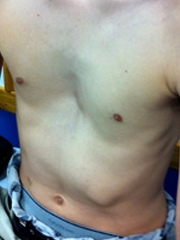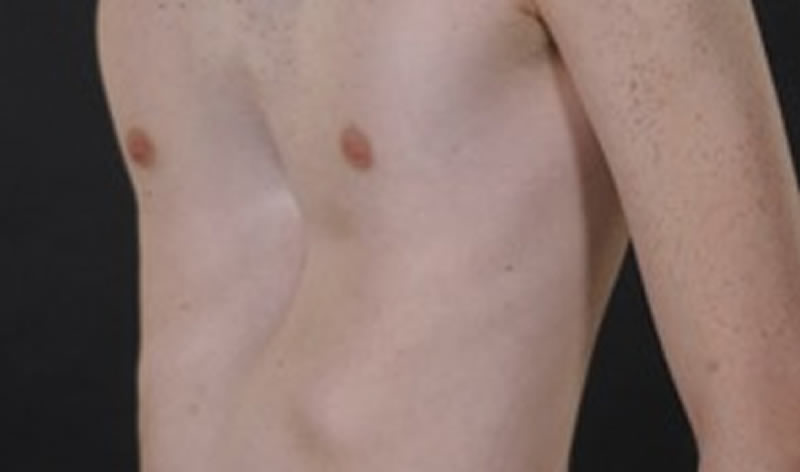pectus excavatum baby nhs
Pectus carinatum pigeon chest is when part of your childs breastbone is pressed outwards or raised up. Also called funnel chest pectus excavatum is more common in boys than in girls.

Pectus Excavatum Funnel Chest British Lung Foundation
It often presents with poor posture and pain and can cause issues with breathing and self-esteem.

. The condition affects more boys than girls. Recent studies revealed that pectus excavatum in babies may be genetic. Increasingly it is being used as a way of lifting the breastbone temporarily during the Nuss procedure.
Why does it occur. A curved steel bar is placed under the sternum through small cuts on either side of the chest wall which pushes the sternum forward. What is pectus excavatum.
This information from Great Ormond Street Hospital GOSH is about pectus excavatum also known as funnel chest. Pectus excavatum is a condition in which instead of being level with the ribs the breastbone sternum is sunken so that the middle of the chest looks caved in. Problems associated with pectus excavatum are mainly cosmetic although the condition can.
There are a range of pectus deformities ie. PE or funnel chest appears as a depression of the sternum. Abnormal growth of the ribs and sternum causes.
Pectus excavatum PE and pectus carinatum PC are the most common of these. Pectus excavatum is a fairly common congenital there at birth deformity. There is a 31 male-to-female ratio.
But even mild cases of pectus excavatum can make children feel self-conscious about their appearance. Asymmetrical shapes of the deformity are more common in older patients and not babies. Studies say that 1 out of 500 children struggle with this malformation.
Pigeon chest develops differently in different people. Pectus excavatum is a structural deformity of the anterior thoracic wall in which the sternum and rib cage are shaped abnormally. Usually the ribs and sternum go outward at the front of the chest.
It is thought to be an inherited condition. Pectus excavatum can impair cardiac and respiratory function and cause pain in the chest and back. There are two main types of anomaly.
This causes a depression of the sternum and the chest has a sunken in or funnel chest appearance. The Nuss procedure minimally invasive repair of pectus excavatum MIRPE The Nuss procedure also known as the MIRPE is a minimally invasive technique. Pectus excavatum is a congenital deformity of the chest wall that causes several ribs and the breastbone sternum to grow in an inward direction.
It occurs more often in men than women. Investigations Radio-imaging with CXR is the first-line investigation. Pectus abnormalities cover a range of deformities affecting the anterior chest wall specifically the sternum and adjacent rib cartilages.
Pectus excavatum funnel chest is when your childs breastbone is pressed inwards and they have a dip between their ribs. The bar is fixed firmly to the chest wall with a metal wire. The condition is the most common congenital wall deformity.
Pectus excavatum affects about 1 in 1000 children and is four times as common in boys as in girls. Pectus excavatum tends to occur at or soon after birth in some people. Some children with funnel chest will live a normal life.
Although it is often in teenage years. The deformity may be symmetrical the same on both sides or may be more prominent on one side of the chest. Pectus excavatum is a congenital anomaly.
This can lead to discomfort andor shortness of breath. This is sometimes referred to as pigeon chested due to a protruding sternum and ribs. The pectus may become more severe or apparent during periods of rapid growth.
Patients should seek treatment if they are having physical symptoms andor psychological symptoms from their pectus. The most common congenital deformity of this kind. For others it may affect their heart or lung function.
People with the condition may. There are some reports of good results in young patients with pliable anterior chest walls as a standalone treatment though long-term results and application in older. This is caused by abnormally shaped ribs.
It can push forward the top side or bottom of the breastbone so that it sticks out. What causes pectus excavatum. Vacuum Bell Therapy is a recently developed pioneering non-surgical treatment for pectus excavatum.
Pectus excavatum also known as funnel chest is a condition in which instead of being level with the ribs the breastbone sternum is sunken so that the middle of the chest looks caved in. The breastbone or sternum and some of the ribs grow abnormally causing a depression in the middle of the chest. Description Pectus excavatum is an abnormality of the chest in which the breastbone sinks inward sometimes called funnel chest.
What is pectus excavatum Pectus excavatum is a congenital chest wall deformity that is caused by growth abnormality of the cartilage that connects the ribs to the breastbone sternum. Pectus excavatum funnel chest is a condition where the front of the chest is sunken. The condition is not always noticeable at birth but is often apparent by the time a child is 2 to 3.
Pectus Excavatum can be noticeable soon after birth. With pectus excavatum the sternum goes inward to. This produces a caved-in or sunken appearance of the chestIt can either be present at birth or develop after puberty.
Pectus excavatum PECK-tuss ex-kuh-VAW-tum is a condition that causes a childs chest to look sunken or caved in It happens because of a defect in the tough connective tissue cartilage that holds the bony part of the ribs to the breastbone. Pectus excavatum or sunken chest is the most common chest wall deformity and is caused by abnormal growth of the costal cartilage junction between the ribs and sternum. The depression may be in the center of the chest or more pronounced on one side.
Surgery can correct the deformity. In the majority however it occurs following a growth spurt. It may be asymmetrical with the right side deeper.
The deformity can result in increased pressure on the heart and lungs during the growing period. Pectus Excavatum can appear as a symptom of Marfan syndrome a genetic disorder of the bodys connective tissue or sometimes alongside scoliosis curvature of the spine. Severe cases of pectus excavatum can eventually interfere with the function of the heart and lungs.
Pectus excavatum also known as concave chest or funnel chest is a deformity of your childs chest wall. Pectus excavatum affects about 1 in 1000 children and is four times as common in boys as in girls. It is the most common deformity of the anterior chest in children and is present in between 1 in 300-400 live births.
It usually first develops during a rapid growth spurt in children and adolescents aged 10 and older. Pectus excavatum also known as funnel chestsunken chest in which the sternum is sunken inwards and the chest looks hollow Pectus carinatum also known as pigeon chest in which the sternum is raised and the chest pushed out. Pectus excavatum affects about one in 1000 children and is four times as common.
Pectus excavatum also referred to as sunken chest is a depression in the chest wall. A child can be born with pectus or develop their pectus during their pubertal growth spurt.

An Extensive Guide To Pectus Excavatum Find Expert Advice

Best 4 Pectus Excavatum Exercises Forget About Surgery Pectus Excavatum Exercise Bad Posture

Pectus Excavatum Children S Hospital Of Philadelphia

Pectus Excavatum Chest Wall Stanford Children S Health

Chest Wall Deformity British Association Of Paediatric Surgeons

Halt To Funding For Chest Deformity Surgery Is A Cruel Blow Rcni


